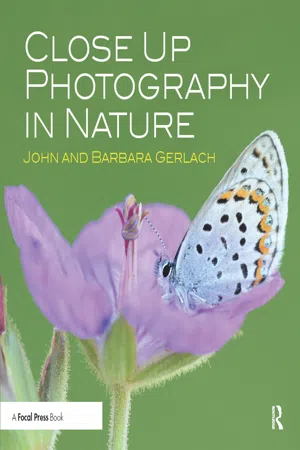
- 202 pages
- English
- ePUB (mobile friendly)
- Available on iOS & Android
Close Up Photography in Nature
About this book
Capturing the grandeur of landscapes or mood of a certain natural light is challenging but often the simple details of a texture or color evade photographers most of all. In Close Up Photography in Nature, best-selling authors and nature photography pros, John and Barbara Gerlach, share the tips and techniques necessary to successfully photograph the beauty all around you.
The Gerlachs are celebrated teachers who understand a photographer's mind so they begin this book with a brief overview of the fundamentals before delving into some of the more advanced and unique challenges of close up photography. Topics covered include: advanced flash techniques specific for close up shooting, as well as a discussion on focus stacking strategies and tilt-shift lenses for getting maximum depth-of-field. The Gerlachs also discuss their strategy of mixing flash with natural light when shooting close up, which opens up all sorts of photographic possibilities – opening up shadows, creating shadows, separating the subject from the background, reducing contrast between the subject and the background, improving the color rendition, shooting sharper images, and much more. This book will change the way you see the world as well as the way you share it through your work! the world through your work!
Frequently asked questions
- Essential is ideal for learners and professionals who enjoy exploring a wide range of subjects. Access the Essential Library with 800,000+ trusted titles and best-sellers across business, personal growth, and the humanities. Includes unlimited reading time and Standard Read Aloud voice.
- Complete: Perfect for advanced learners and researchers needing full, unrestricted access. Unlock 1.4M+ books across hundreds of subjects, including academic and specialized titles. The Complete Plan also includes advanced features like Premium Read Aloud and Research Assistant.
Please note we cannot support devices running on iOS 13 and Android 7 or earlier. Learn more about using the app.
Information
1 Cameras and Lenses

Crop Factor vs. Full-Frame Cameras

Features to Look for in a Camera
High Megapixel Count
Back-Button Focus
RGB Histogram
Live View
Live Histogram

Taking Advantage of Camera Options
Color Space
Image Size on the LCD
Reverse the Exposure Control Dials
Table of contents
- Cover Page
- Half-Title Page
- Title Page
- Copyright Page
- Table Of Contents
- Acknowledgments
- Introduction
- Chapter 1 Cameras and Lenses
- Chapter 2 Exposure Essentials
- Chapter 3 Shooting Sharp Images
- Chapter 4 Light and Color
- Chapter 5 The Power of Flash
- Chapter 6 Photographing Flowers
- Chapter 7 Special Photo Techniques for Butterflies and Dragonflies
- Chapter 8 What's in Our Camera Bags?
- Appendix: Resources
- Index